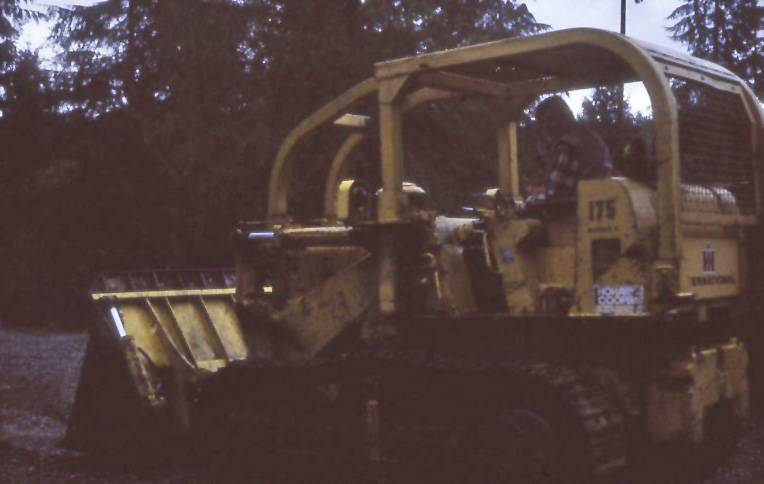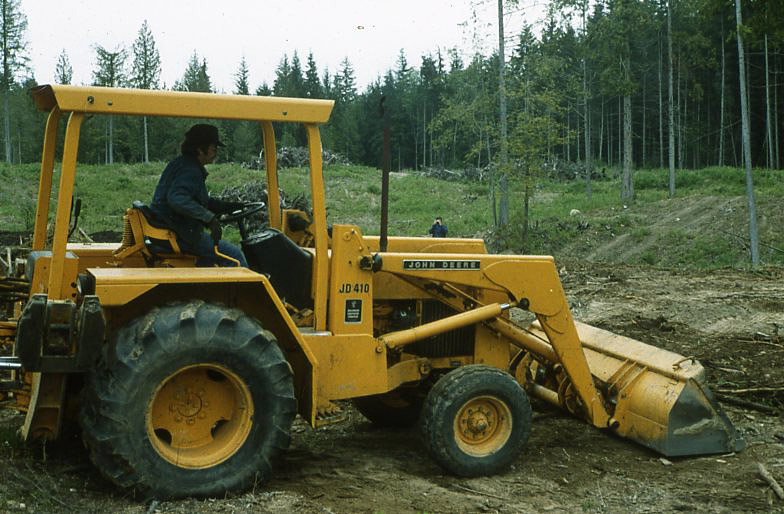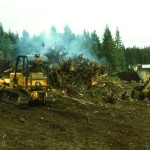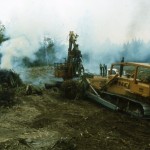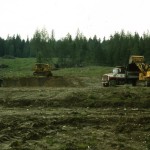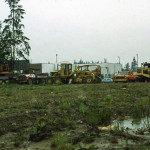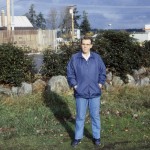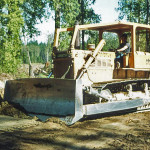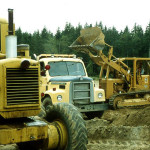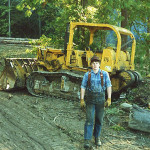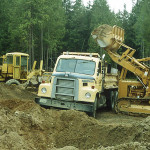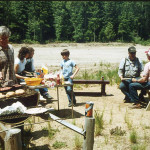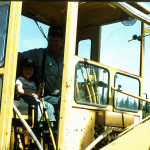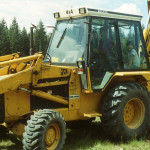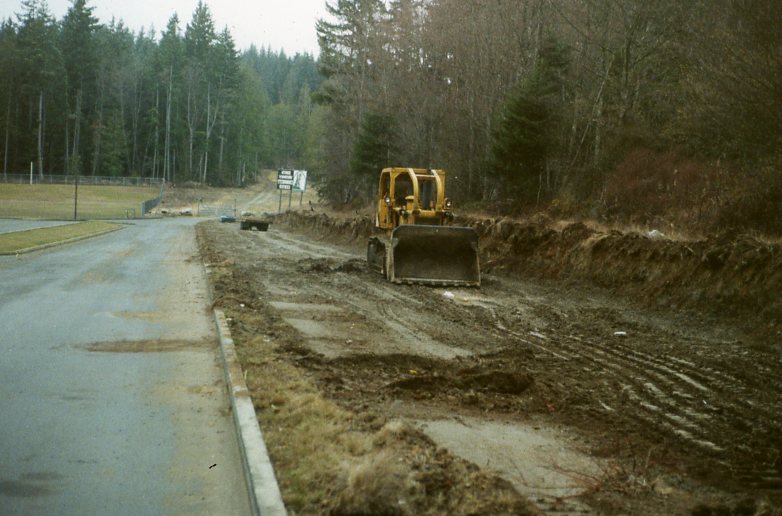The forty-three acre park site was acquired in Sept. 1981. Tim never stopped promoting the development of the park. Public speaking, newspaper articles informing the public as projects were accomplished, receiving letters of endorsement from community leaders, etc. …….. Tim kept moving the project forward. The people who were responsible for the accomplishments that took place were appreciated and thanked. They were the source of inspiration for those who kept stepping forward to do their part as the development moved ahead.
For the most part, the Board Members of the nonprofit organization, South Whidbey Recreation, through which the land was received and much work was accomplished prior to the establishment of the South Whidbey Park and Recreation District agreed with and approved Tim Scriven’s proposals for action, but it was not without conflict. There was not always a sense of collaboration and encouragement regardless of the remarkable results and the core reasons for building the South Whidbey Community Center. Board Member Dave Anderson was the exception to this in the beginning and Board Member, Al Good was also involved with many of the projects as will be mentioned further as the story is told. Then several years into the park’s development, Kenny Bloom did a ton of work on the various building projects which will be shared in more detail later in the story. Kenny also served as a commissioner of the South Whidbey Parks & Recreation District.
Throughout the years another Parks & Recreation District Commissioner, Curt Gordon, was always involved during the initial eight year development of the park complex at the heavy equipment work parties. Near the end of the park’s development, Curt took on the role of project coordinator for finishing the southern most athletic field. Despite the problems, much was accomplished and the community received the gift of a park complex which provided a venue for perpetual opportunities for interaction among the age groups. A venue for teaching, caring and positive experiences was achieved.
1982-1984
Now the planning moved to execution! May 1982. Bob Moch donated a complete soils analysis of the forty-three acre Community Center site. Albert Gabelein donated his bulldozer and built four roads on the property which Bob utilized to gain access to locations throughout the property. A representative of the Island County Health Dept. was present to record the data from each of the thirty soil log holes.
Dave Anderson was the first to bring his bulldozer to the park site for the purpose of removing stumps and slash. Johnny Gabelein transported Dave’s bulldozer to the site and then Wally Lehman brought his bulldozer over to work with Dave. Their effort preceded the idea to invite the Navy Sea Bees and the concept of the Banner Days event which followed the eventual removal of the stumps by the Sea Bees. Both projects will be explained further later in the story.
Dave said that he didn’t think that he could accomplish too much with his old machine but he wanted to plant a seed for the idea of people donating their equipment toward the park improvement effort. Dave then referred to his bulldozer as a “seed cat”. The idea started by Dave and Wally along with donations of work by Albert Gabelein, Bobby Moch and Mike Shelton, who also donated equipment prior to Banner Days, all played an important role in its great success. Wally and Dave tried working together with their machines to remove the stubborn stumps and after a short while Dave’s cat broke down. Randy Bradley brought over his portable welding rig and Tim Scriven crawled under Dave’s cat and made the repair. Randy donated his low-boy trailer and returned Dave’s bulldozer for him.
What Wally and Dave did in 1982, proved that the Douglas fir stumps were too big for the volunteers to handle without damaging their machines and incurring expenses that were excessive for them. The work that the Navy Sea Bees did in June 1984, following the establishment of the South Whidbey Park and Recreation District, November 1983, was a pivotal accomplishment toward moving the development of the park forward. Our fledgling nonprofit organization could not have come up with the money for such a large and expensive job as removing thirty acres of stumps. The 1985 Banner Days event was possible and its success was largely a consequence of what the Navy Sea Bees did and the other work that preceded it.
Before receiving the commitment from the Sea Bees to remove the stumps, many people knew Tim Scriven must be a fool to keep trying to accomplish seemingly impossible things. He didn’t argue this perspective but he never lost faith either. During periods of uncertainty it was like sledding uphill for days and weeks at a time for Tim. His quest to build a complex that would serve the age groups and benefit children was always on his mind.
In September 1982, Coach Carl Westling presented an idea for a jogging trail to Tim Scriven who then coordinated the project. The trail layout was done by Doug Alderdice. Bob Moch donated his bulldozer to build the trail through the forest on the south and east boundaries of the park. Many South Whidbey residents have enjoyed using the trail ever since including many high school track athletes, as Carl originally envisioned.
Now the land was ready to be cleared. Waterman Mill had logged the property in 1981 as part of the purchase/donation agreement. Then in June 1984 the Navy Sea Bees from the Whidbey Island Naval Air Station removed the stumps and piled them with other debris for burning at the South Whidbey Community Center site.
The initial request to the Navy was made by Tim Scriven. Dorothy Gray and Dorothy McCann were invited by Tim to go with him to meet Capt. Langdon. When Tim followed the ladies into the Commanding Officer’s office at the Naval Air Station in Oak Harbor he received instant credibility from the Captain. The two petite grandmothers captured the Captain’s heart instantly. Without speaking a single word they accomplished what Tim alone could not have.
After a brief explanation of the reasoning behind the proposed park complex, Tim asked Captain Langdon to tell him the steps needed to be taken in order to gain his approval for the Sea Bees doing the work. Tim wrote the steps down as Captain Langdon stated them, the steps were followed and what had seemed insurmountable was accomplished as the large Douglas fir stumps were removed by CB Unit 417 in 1984.
The value of this accomplishment cannot be overstated. It got things moving forward again in a big way! From the stand point of the money that was saved to the community it was obviously very important. But, the Sea Bees work also provided lots of great publicity and interest which provided momentum for what needed to happen next. Everything explained in this story that happened before the Sea Bees, along with the work the Navy Sea Bees accomplished, brought more people to realize that the development of the park complex was achievable and many enthusiastically told their neighbors and friends.
1985
Banner Days: first work party
March 1985 was the time of a weekend event that Tim Scriven named Banner Days. The name came from the expression, “it’s a banner day.” And, also from a desire to build a bridge between the service and civic groups in the community with those who donated their time and equipment during the event. To make the connection of support visual Tim invited the community organizations to display their banners on the equipment that was donated by private individuals and construction companies. From the beginning it was an objective of those building the park to provide exposure and appreciation for the many organizations that were historically responsible for the comprehensive benefits to the community that they collectively and traditionally achieved.
The Banner Days event was fun for those who attended to observe the work and for those who participated. All of the projects that had been accomplished to that point contributed collectively to the remarkable work that the equipment owners and others came to do. March 1985. A well was drilled by Joe Lehman at the request of Tim Scriven.
Joe donated his time and equipment and also sold the casing, drive shoe and screens at $550.00 below his cost. Fund raising for the purchase of the materials was accomplished through the efforts of Tim Scriven. At Tim’s request Joe provided him with a formal contract which Tim used to share Joe’s generous contribution while Tim approached people for donations of money to be used for the hard cost items of the well.
(Hover over an image for a description. Click on an image to enlarge it and view a manual slideshow.)
- Donors who contributed to the success of one of the first work parties where heavy equipment was used.
- Harold Hagglund & Bob Windecker donated their equipment to clear the Community Center site and burn stumps and debris.
- Wally Lehman donated his bulldozer.
- Mel Simmons and his bulldozer.
- Al Kittleson & Harold Hagglund and their equipment.
- Randy Bradley and bulldozer.
- Bob Moch and his backhoe.
- Ernie Leiske and his log loader to pile stumps for burning.
- Bulldozer operator Mike Madsen and Ernie Leiske.
- Jim Rudd and his skidder removing fallen trees.
- Bob Moch and Charlie Dunham.
- SWAA youth assisting with the burning of debris.
- Mike Madsen.
- J.T. Madsen.
- Feeding the troops.
In August of 1985 Herb Hunt donated a copy of the conceptual drawing of the South Whidbey Community Center mounted on a Styrofoam board. Tim used the large 24” x 36” drawing to inform groups while promoting the development of the park during his public speaking engagements. Great appreciation is given to architect, Jon Thomas and his partner Tony Shults of the Quorum who created the conceptual drawing by utilizing the ideas and information that were approved at the board meetings.
1986
Hanford Thayer donated his engineering services and developed a grading plan for the excavation of the northern athletic field. Later Hanford donated grading plans for the southern most athletic field and the other multipurpose fields.and the other multipurpose fields. All along Hanford Thayer played a critical role in providing a wide variety of engineering services. Without the donation of Hanford‘s professional time, progress probably would have been stopped. He attended almost every meeting and was present for all of the work as it was done. Hanford always had a smile, always was kind to everyone and was always diligent in providing his engineering designs and in procuring the necessary permits. It would be worthwhile to contact the Island County Planning Dept. to procure a list of the engineering accomplishments that Hanford provided. Someone qualified for the task of assessing the cost value of Hanford‘s engineering contributions for 8 years could then be asked to make an assessment of his work on that basis.
The Second Heavy Equipment Work Party
In March of 1986 a second work party was held on the park site for the purpose of building athletic fields and doing additional clearing. Many of those who donated their time and expertise at the Banner Days work party, the year before, came back to continue what they had started. New volunteers also joined in the effort. Ladonna Thorsen flew her airplane over the property and Harvey Friesen, Jr., took aerial pictures.

Aerial photograph – LaDonna Thorsen pilot, Harvey Friesen Jr. photographs.
Donating expensive earth moving equipment is unheard of especially when many of those who donated it worked in competition with each other through their construction companies. The guys, along with Myrna Bradley, for the most part had very little free time as keeping their small companies afloat meant working weekends and evenings bidding future jobs, repairing and maintaining stuff and fighting what the government and weather might throw at them….. and on and on! There are many reasons for not giving, and there are many times when giving isn’t possible. What took place is truly extraordinary.
During the March 1986 work party the guys worked all weekend having moved their equipment in the Friday before. The accomplishments that preceded the March 1986 event probably inspired and motivated them. Often the achievements of caring people create the inspiration and momentum for other good things to follow.
Leading up to the second work party, Tim Scriven had continued to arrange fund raising, publicity and to invite people to participate in various projects. He conceived the idea for a second nonprofit organization to be formed to replace South Whidbey Recreation which was dissolved once the South Whidbey Park and Recreation District had been established. The new organization was named the South Whidbey Progressive Club and was founded in Jan. 1986.
The new organization served as a booster club for the development of the park making it possible to continue the effort in the same manner as before. This was necessary because the South Whidbey Park and Recreation District did not have money to operate with when it was established. Two consecutive levies failed to pass by the frugal voters.
To demonstrate a broad base of support, many community leaders were named to the Progressive Club’s Advisory Board. They were people who had supported the park effort in the past. Tim used tactics of all kinds in concert with each other to maintain momentum and credibility for the volunteer based development which was required for approximately 8 years as work on the park progressed.
Jack Siebert, owner of Tri County Surveying, had donated the topographic survey in Feb. 1984, which was an essential and invaluable gift to the project. Engineer, Hanford Thayer used Jack’s survey to do the grading plan. Hanford designed the drainage plan as well as other engineering requirements and with the help of Tom Roehl, a planning consultant, acquired the necessary permits from the County. Electrical engineer, Jim Duncan, also worked with Hanford designing the electrical system for the park complex.
Tim was always utilizing momentum from past accomplishments to keep the ball rolling for what needed to be accomplished next. Seemingly things just happen by themselves, though the reality is that is not the case. Constantly informing the community through public speaking, the newspaper and word of mouth was important to maintaining momentum and good will for future accomplishments.
(Hover over an image for a description. Click on an image to enlarge it and view a manual slideshow.)
- Earth moving equipment assembled on the lower athletic field.
- Earth moving equipment assembled on the lower athletic field.
- Ray Kinskie operating Art Kinskie’s bulldozer.
- Lloyd Schumacher operating his backhoe.
- Steve Owensby driving Bob Key’s dump truck.
- Keith Wrightsman dump truck.
- Myrna Bradley dump truck.
- John Bradley and great-grandson Ryan with Bradley’s turn-a-pull.
- Myrna Bradley and children in dump truck.
- Sandy Sandberg- Sandy donated the use of his D-8 bulldozer for about a week.
- Feeding the troops.
- Donors who contributed to the success of one of the work parties.
The Third Heavy Equipment Work Party
The May 17-18, 1986 weekend work party focused on excavating approximately 8,000 cubic yards of soil for construction of the athletic field located near the southern portion of the forty-three acre park site. Randy Bradley took the initiative to speak with Tim Scriven and Hanford Thayer about the importance of doing additional work almost immediately after a large volunteer project using heavy equipment had been accomplished in March, just two months prior.
Randy took on the role of project manager and developed a plan with Hanford and then Randy called the volunteers who did the work. Tim promoted the project and raised money through the South Whidbey Progressive Club.
Those who came to donate their time and equipment had given in the past. Bradley Construction donated two bulldozers and a dump truck with Randy operating equipment, Myrna driving the dump truck and Mike and JT Madsen involved as operators. George Paris donated his bulldozer and Everet Peterson operated a bulldozer donated by Frank Todd. Bob Keys and Jerry Stonebridge donated dump trucks.
The South Whidbey Park and Recreation District was established without a tax base and the first two levies failed to win voter approval. An example of the community spirit which supported the work of the volunteers mentioned above, however, was displayed by the contribution that Nichols Brothers Boat Builders made in 1986 with the employees raising $800 along with the company matching the employees’ effort, for a total donation of $1,600.
Robin Flem sent out 150 letters in August of 1986 promoting the community park effort and requesting contributions to the South Whidbey Progressive Club. Approximately $500 was received in response to his effort.
A broad based support was promoted and the collective efforts of all involved carried the project forward without tax money being available for the first six years. It was the persistence of those who kept on getting work accomplished on a volunteer basis, that more than anything won the approval of the voters for the passage of the levy on its third attempt, along with a letter to the Editor of the South Whidbey Record promising a broad based funding concept that was approved by the Park and Rec. Dist. Commissioners.
Randy Bradley and Hanford Thayer were constant collaborators and partners of Tim Scriven. Tim could count on them for accomplishing work as the development of the forty-three acre site continued from project to project over the years. The three of them maintained a constant presence while conceiving, planning and organizing specific jobs. It never became a problem for one to contact the other. They were independently committed to building the park complex for their community for their own individual reasons. Yet, they were mutually dependent on each other for the results that they achieved project after project, year after year.
(Hover over an image for a description. Click on an image to enlarge it and view a manual slideshow.)
- Mike Madsen on the Kamatsu bulldozer donated by Bradley Construction.
- Everett Peterson operating the Kamatsu.
- Ladd Wilmoth operating a bulldozer donated by Stonebridge Construction.
- Pete Krogseng, George Paris donated their equipment with Joe Lehman operating the Bradley’s road grader.
- Mike Madsen – bulldozer.
- George Paris, dump truck; Pete Krogseng, bulldozer; Randy Bradley, road grader.
- Mike Madsen operating the Bradley turn-a-pull.
- Randy Bradley welding his turn-a-pull with Joe Lehman and Ray Kinskie.
- Mike Madsen delivering a bulldozer being donated by Bradley Construction.
- George Paris – dump truck; Pete Krogseng – bulldozer; Wally Lehman –bulldozer; Mike Madsen – turn-a-pull.
- Al Good, Patty McGlenn, Georgia Scriven, Clint Scriven, Randy Bradley, Hanford Thayer.
- Randy Bradley and grandson Ryan on the Bradley road grader.
- Joe Lehman operating the Bradley road grader.
- Curt Gordon operating the road grader donated by Karl Krieg.
- George Paris, Curt Gordon, Hanford Thayer, Mike Madsen, Randy Bradley enjoying lunch prepared and served by Tim and Georgia Scriven.
Finishing and planting the athletic fields
In the summer of 1986 the heavy equipment contractors had finalized the clearing and excavation work at the park site with their equipment and it was time to involve people in grooming the property in preparation for planting. Tim Scriven spoke to the South Whidbey Athletic Association regarding the process of picking up rocks, sticks and debris left over from the clearing and excavating. The coaches of the youth teams brought over their players after practice to help. About 150 children and adults joined together in the project.
To coordinate the site preparation and planting, Jim Hansen, a landscaping specialist, donated his time. Many individuals also came out to help. Jim’s leadership was very important to the success of the community effort.

Jim Hansen – project manager of the cleanup and initial planting of grass on the upper and lower athletic fields.
SUMMER 1986 to 1989.
The finishing of the Community Park grounds
Spring 1987. Site preparation of the playground area required stump and slash removal by Jim Scriven who donated his time and bulldozer to the job. The idea for the location of the playground was given to Tim Scriven by Betty Lehman. Tim relayed the idea to Jim who took it upon himself to do the clearing and cleanup for what became a fantastic place for children to play.
The construction of the playground took place several years later and is one of the great achievements of community volunteers. Its story deserves to be told on its own, as it too was a great accomplishment in its own right.
In the summer of 1987 the northern athletic field was named Lehman Field in honor of Wally and Betty Lehman who donated countless hours to youth sporting activities for several generations of South Whidbey children. Chainsaw sculptors Dave Sipes and Pat McVay carved a likeness of Wally Lehman, “The Umpire” from a large log and donated it to remember Wally and Betty. “The Umpire”, was installed near Lehman Field and is an inspiration to us all. Wally’s sons, Jim, Terry and Joe donated their time to improving and maintaining the field.
In the spring of 1988 sand was donated by Frank and Joan Todd and was hauled to the southern athletic field by Curt Gordon, George Paris and Pete Krogseng. Curt Gordon was coordinator for this project and for additional work that followed.
In the summer of 1988 volunteers installed the lateral drainage lines for the southern athletic field. Curt Gordon borrowed Karl Krieg’s trencher for the project and Pete Krogseng donated the use of his backhoe. The pea gravel was hauled by dump truck operators, Myrna Bradley and John Johannsen. There was also a large turnout of individuals who participated in providing the labor required by hand to install the drainage system. Food and drinks were donated and hamburgers were prepared barbecue style for those who attended.
Bill Bergthold donated his time and equipment to install the sprinkler system for the southern athletic field. The materials were purchased by the South Whidbey Park and Recreation District.
- Bill Bergthold with his equipment installing the sprinkler system for the athletic field located near the south boundary of the park.
- Myrna Bradley hauling pea gravel for lateral drains.
- John Johansson hauling pea gravel with Curt Gordon’s dump truck.
- Hanford Thayer surveying the height of the lateral drain lines for the upper athletic field, assisted by Georgia Scriven.
- Pete Krogseng donated the use of his backhoe for hauling pea gravel for the lateral drains.
- Curt Gordon, project coordinator, digging trenches for lateral drains using trencher donated by Karl Krieg.
- Curt Gordon, Hanford Thayer, Jim Porter, Ryan Porter, Pete Krogseng, and Bill Bergthold placing drain pipe in trenches.
- Pete Krogseng – backhoe, Jim & Ryan Porter placing pea gravel in the drainage trenches.
- Georgia Scriven, Jim & Ryan Porter and Hanford Thayer working on lateral drains.
On Saturday November 12, 1988 a volunteer work party was organized by Randy Bradley to excavate soil from a 30 ft. easement leading from Maxwelton Rd. to the South Whidbey Community Center site. The easement was donated by Arthur and Dora Gabelein for ingress, egress and utilities to the Community Center.
Alongside the Gabelein easement is a second easement 40 ft. wide donated by the South Whidbey School District. The School Districteasement is a paved road which is available for the public to use for access to Community Park site. Legal services to acquire the easements were donated by Ross Jacobson. Pacific Northwest Escrow and Island Title participated cooperatively with Ross. Tim Scriven conceived the idea for the easement and negotiated with the property owners to arrange the agreement for it with them.
The South Whidbey Park & Recreation District paid Puget Power about $21,000 to install underground power to the Community Center site. The work that the S.W. Progressive Club volunteers achieved was in preparation for the work that Puget Power accomplished afterward.
Curt Gordon, South Whidbey Park & Rec. Dist. Commissioner, asked Randy Bradley to organize the work party for excavating the soil from the Gabelein easement and Randy immediately thought of the need which the S.W. Eagles Club had for fill material at their new building site. The contractors and operators who donated their time and equipment did so knowing that two worthwhile community building projects would be accommodated at the same time from their work.
Those who participated were: Jim Scriven, dump truck; Greg Capes, dump truck; Curt Gordon, dump truck; Myrna Bradley, dump truck; and Everett Peterson and Tom Reynolds, operators of the excavator donated by Bradley Construction. A special thanks to Arthur and Dora Gabelein for donating the soil from their property to the South Whidbey Eagles. Eagle’s members Bill Dunlap and Bob Keys donated equipment at the Eagles site where the Eagles built their facility which has been serving the community for many years since.
Jim Scriven donated a treated power pole which he and Buck Walters installed at Maxwelton Road in the fall of 1986. This pole received the power line crossing over Maxwelton Road. The power line connects to the top of the pole and then runs down the pole where it enters the ground and travels from that point to the South Whidbey Community Center. Jim Scriven also put in many hours on his own, before the Eagles work party, excavating the Gabelein easement. A special thanks to engineer Hanford Thayer and electrical engineer Jim Duncan for their professional counseling and services.
Landscape professional Dan Lett donated his rock hound, tractor and hydro seeder to complete the cleanup, grading and planting of Lehman field. Dan agreed to seed the field early in the spring of 1989. The South Whidbey Park and Recreation District purchased the hydro seed mix which Dan used. Joe and Leland Long donated fertilizer from their chicken ranch for the fields and approximately $500 worth of pellet fertilizer was purchased by the South Whidbey Progressive Club also for use on the fields.

Dan Lett’s tractor and hydro seeder which will be used to plant the grass on the upper athletic field.

